In the pre-internet era, the most influential platform for brand reach and marketing was Television. The visual and auditory capabilities of television were an exciting paradigm to explore and experiment with. Global businesses and brands used this new medium to showcase their products in enthralling ad campaigns that were embedded in the viewer’s memory. As television got cheaper and more widely available, it became the primary means of promotion and marketing, ending much of the relevance of print media.

History Repeats Itself
The world is at a precipice of another evolution – The transition of the monopolized internet (Web2) to the decentralized Web3, poised to reshape the global business landscape. Television enables a multi-sensory experience that transcends the effectiveness of print media and appeals to a national audience. Similarly, the borderless digital economy of Web3 is ushering in a new era of transparency, permissionless ownership, and global engagement. Brands around the globe are building new customer relationships on these pillars, one that cultivates a brand authenticity that appeals to the new generation of consumers.
Ethereum – The Cornerstone of Web3
Ethereum’s success in creating a robust and versatile smart contract platform has made it the de-facto center stage of this evolution. However, as the fight for block space on the Ethereum network grows higher than a Black Friday sale at an electronics store, the layer-2 space on Ethereum has emerged as the new ground for experimentation. Polygon is one ecosystem swiftly gaining mass appeal among consumers and businesses alike.
This analytical piece will explore the symbiosis between Polygon and the rapid migration of businesses into Web3 to deduce what strategic decisions made by the team led Polygon to become one of the most prominent names in tech and how it will live up to its name with time.
What is Polygon Matic?
The Polygon Network, formerly known as the Matic Network, is a layer-2 scaling solution on the Ethereum network that seeks to solve the scalability and interoperability bottlenecks of the Ethereum mainnet, a product of the infamous scalability trilemma.
A layer-2 like the Polygon is called a plasma blockchain. Plasma is a framework for scaling monolithic blockchains like Ethereum by having multiple blockchains that run in parallel to the parent chain, with the ability to have separate consensus. In plasma, the so-called child chains borrow the security of the parent chain by periodically updating their state to the parent chain. We dive deeper into what Polygon is and everything you need to know about Matic in our dedicated Polygon Matic Review.
Evolution of Polygon
Polygon Network was founded in 2017 by four Mumbai-based software engineers – Jaynti Kanani, Sandeep Nailwal, Anurag Arjun, and Mihailo Bjelic. Since its genesis of Polygon as the Matic Network, Polygon has expanded dramatically in its capability to attract users, innovation, and functionality into the Ethereum ecosystem. Starting out as a simple bridge, the Polygon network offers full-stack solutions on Ethereum. Here is a quick summary of its history –
The Matic Network
Polygon began as a chip off the Ethereum blockchain, designed as an answer to its scalability bottlenecks like skyrocketing gas prices and lackluster throughput. It launched in 2017 as the Matic Network, a plasma scaling solution on top of the Ethereum mainnet. The system processed transactions on the Matic Network (layer2), which got batched together and added to the mainnet periodically to achieve finality, dramatically improving transaction cost and time.
Rebranding to Polygon
With Matic network chains a stellar success, the team soon realized that providing a scaling solution was just a peg of a larger wheel. New blockchain networks were popping up, requiring a standalone validator set to secure the network. This was not only a substantial operational feat but also created isolated silos where liquidity and information were trapped, Web3 was in need of interoperability.
In February 2012, previously Matic Network rebranded to the Polygon Network and expanded its horizons. This transformation was the Matic team’s bid to transform Ethereum into the internet of blockchains, akin to Cosmos and Polkadot. They developed the Polygon SDK, a tool to create layer-2 and sidechains on Ethereum to make this dream come true.
Polygon ZK Rollups
Zero-knowledge proofs are an advanced concept in cryptography core technology that made significant strides in 2022. Realizing its potential as a scaling solution for Ethereum, the Polygon team announced zkEVM, an EVM-equivalent scaling solution powered by zero-knowledge technology.
THE POLYGON ZKEVM
zkEVM worked by batching several transactions into a single package, which got shipped to the Ethereum mainnet with a commitment using zk-proofs. The transaction cost of the commitment on Ethereum splits between all included transactions, dramatically reducing gas and increasing throughput. The zkEVM made it to the testnet in October 2022 and successfully launched its mainnet in March.
Polygon 2.0 – The Value Layer of the Internet
Polygon 2.0 was the project’s most radical upgrade, redefining everything from protocol governance, architecture, core functions, and even tokenomics. The inspiration behind the upgrade was the internet itself. The vision was to create a blockchain network like the internet, with infinite scalability, without sacrificing decentralization. This is achieved by adding more scalability to the network in parallel by building more ZK-powered chains as and when required, with unified liquidity. The hive-like network would instantly connect with one another via a unified cross-chain coordination protocol.
While the above history provides sufficient context for the focus of this article, there is a lot to learn about the Polygon ecosystem. Everything from the network architecture, MATIC tokenomics, and sources to buying it, as well as the top projects on the network, can all be found in a comprehensive analysis done by the Coin Bureau team.
Why Establish a Web3 Presence?
Consistent innovation and growing awareness about Web3 have made it lucrative for the common folk. The experience of using decentralized networks is getting simpler, attracting more users and motivating industries like fashion, sports, and entertainment (more on them later) to explore the new paradigm. Despite the consistent devaluation of the Web3 industry during the bear market, the community has continued to grow and innovate.
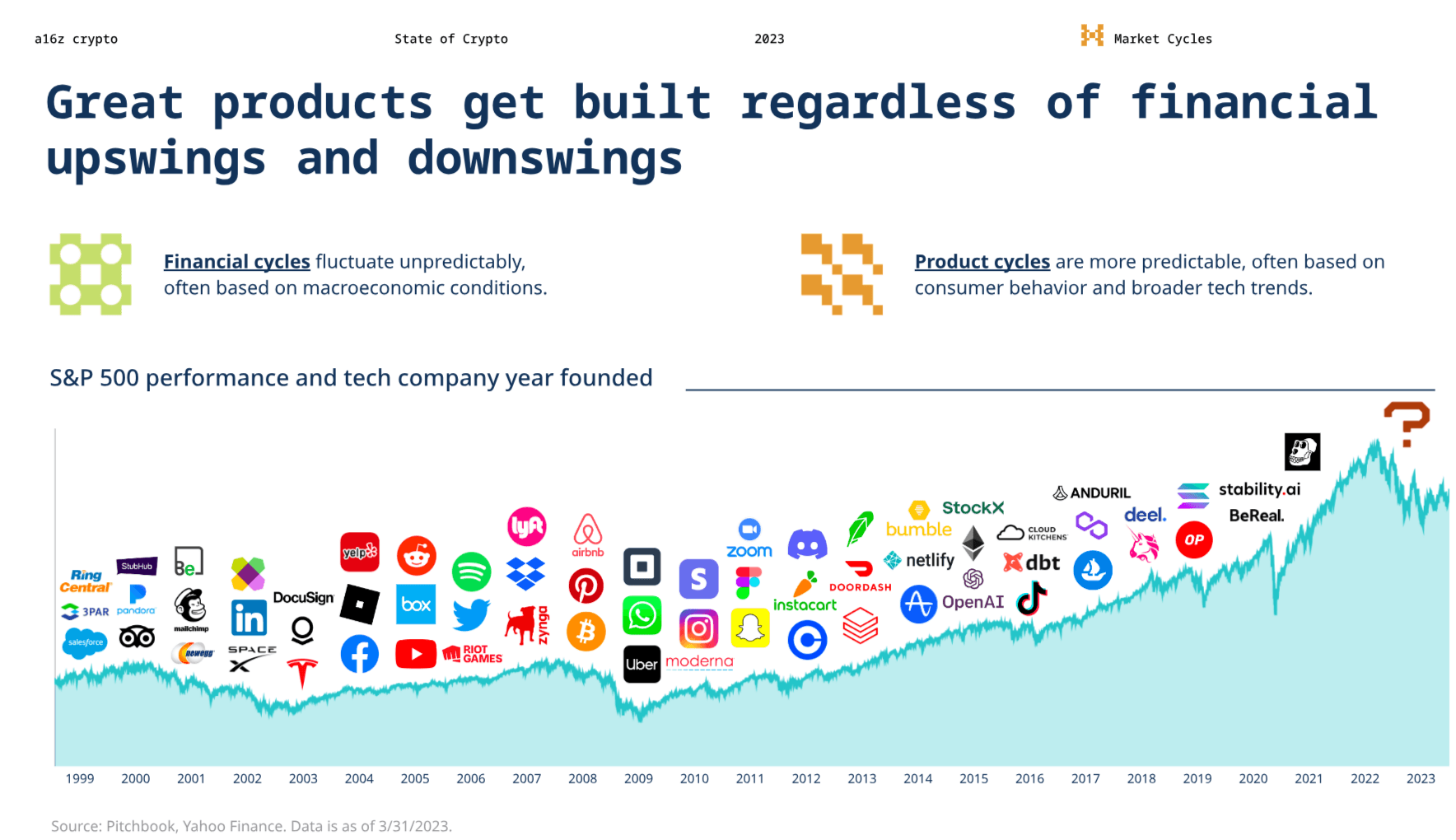
Web3 is an evolving space with immense untapped opportunities, some of which are summarized below –
Strategic Positioning
The Web3 industry has showcased exponential growth in a very short time. Even when the future relevance of this industry remains debatable, non-Web3 native brands have more to gain by embracing this transition than to lose by ignoring it. One who is late to adapt to the change may find themselves stressed in a saturated market.
Monetization
Decentralized finance and the digital token economy of Web3 offer novel business models and revenue streams that businesses can explore. Non-fungible Tokens (NFTs) are a rapidly evolving sector with proven tremendous revenue potential. With NFTs, brands are tokenizing their real-world offerings and creating new digital goods that complement their primary business models.
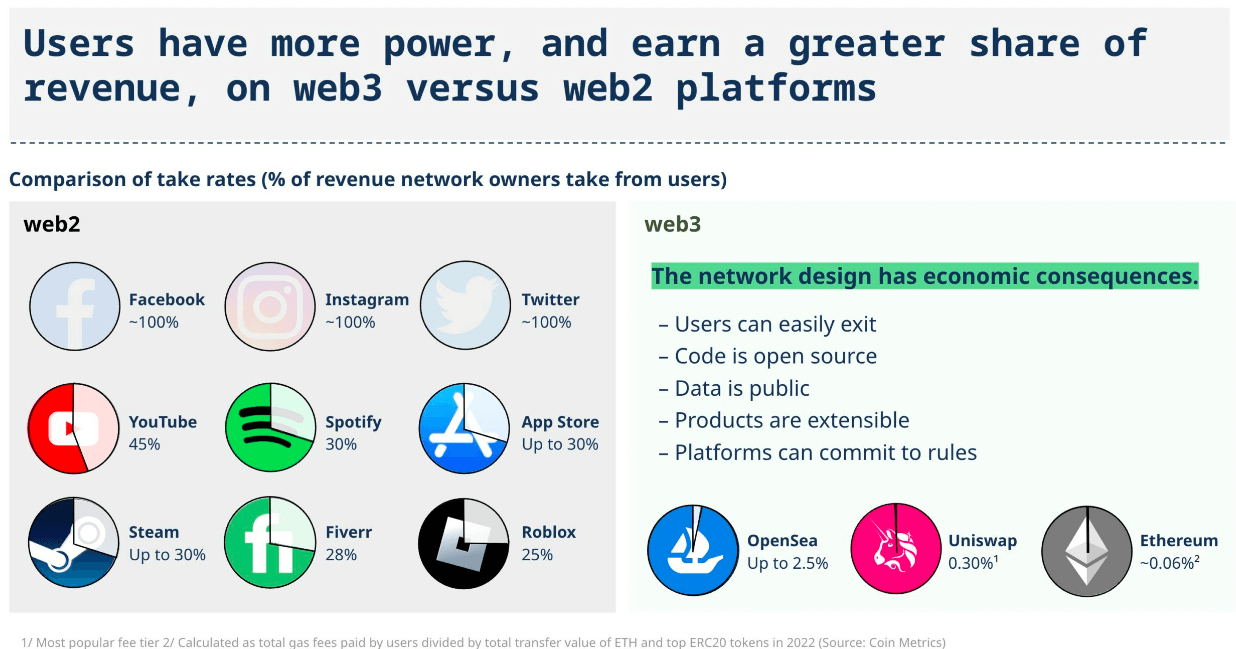
Platforms that value creators attract great talent, and incredible talent attracts many fans and enthusiasts, attracting more creators. This feedback loop was perhaps behind the blockbuster success of the NFT industry. The entry of Web2 entities into the scene will only accentuate this cycle, which benefits everyone involved.
Cultivating Relationships
Traditional marketing campaigns foster brand loyalty with compelling advertisements and promotional discounts. In contrast, Web3 incentivizes loyalty with ownership. DAO and NFT token holders often have the power to steer the direction of the community. The added sense of responsibility and belongingness builds a stronger community and brand loyalty.
Web3 also answers the growing awareness about online privacy and ownership of one’s own personal data. Traditional marketing strategies are built on targeted ads and the collection of personal data, whereas Web3 offers anonymity and encourages privacy rights. This may encourage members to be more active in the community.
Networking
Web3 communities like DAOs and ecosystems are always bustling with activity and engagement. Moreover, community participants are known to be very loyal and motivated toward the community’s betterment, regardless of an increasingly hostile economic and regulatory environment. Strategic partnerships with such communities can give brands exposure to the audience they are ideally looking for.
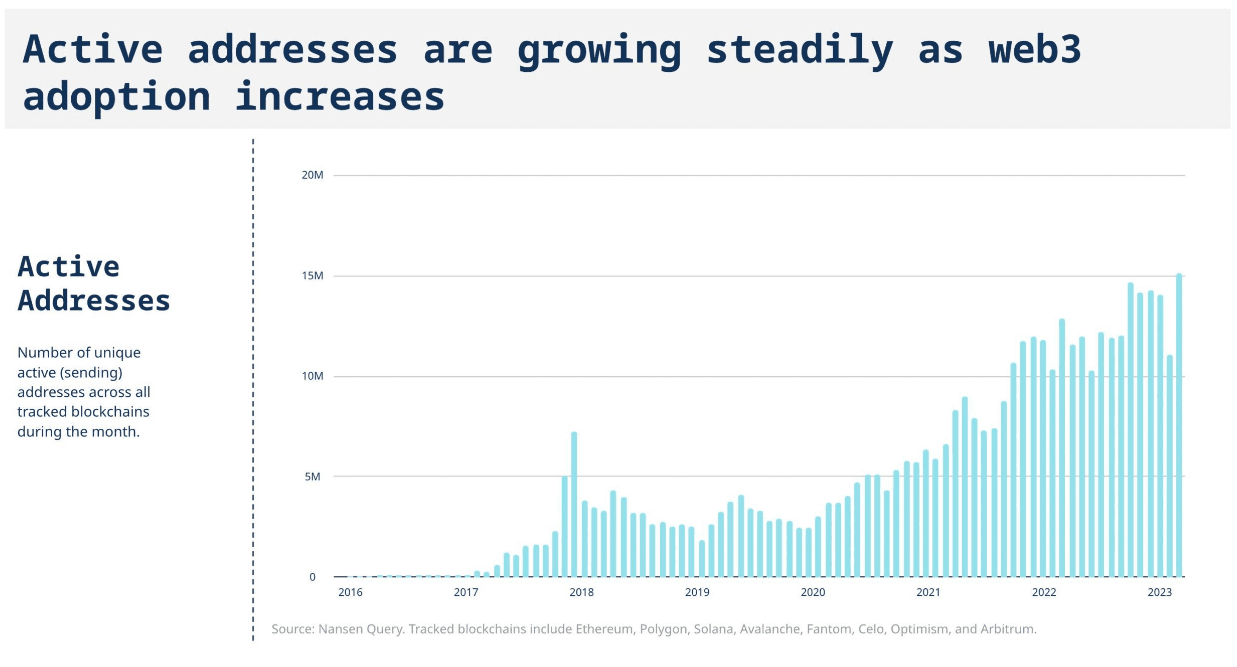
A crypto community, which is often intrinsically global, offers new marketing channels that engage with members without knowing geographical boundaries. Brands often partner with specific DAOs or ecosystems to gain exposure to their community.
Diversification
Web3 is the most economical direction for expansion for a business. Building a thriving Web3 community or a marketing campaign is surprisingly easy due to the abundance of open-source tools and easy distribution of digital media.
Security and Privacy
The privacy and security of any Web3 community is inherently nurtured by the underlying blockchain network. This eliminates the risks associated with centralized control, like coercion and data breach.
In conclusion, as Web3 continues to evolve, we’re likely to see even more partnerships form as businesses strive to remain competitive, innovative, and responsive to changing consumer preferences.
Polygon’s Key Partnerships
Polygon is leading the charge when it comes to partnerships formed with traditional Web2 companies. Polygon has partnered with brands that span several industries, here are some of the notable ones –
Polygon Partnerships in Finance
Polygon x Mastercard
In January 2023, Mastercard initiated its Artist Accelerator Program on the Polygon blockchain to empower emerging musical talent with Web3 and its networking capabilities. Kicking off in spring 2023, the program mentored five artists, providing them the tools and guidance to build their brand using Web3 technologies like NFTs. The initiative was announced in collaboration with Polygon Studios at the Las Vegas Consumer Electronics Show (CES).
Empowering Talent with Polygon
The program seeks to integrate emerging passion and technology, offering talent a unique growth space. With a history of sponsoring musical initiatives like the GRAMMY awards, this partnership accentuates Mastercard’s belief in the potential of Web3 in fostering an innovative platform in the cutthroat business of music.
Polygon x Robinhood
Robinhood, the famous stock and cryptocurrency trading app, recently launched a crypto wallets feature for its select waitlist users. In a later announcement, Polygon confirmed that the deposit, withdrawal, and transactions with Robinhood’s crypto wallets will be facilitated through the Polygon blockchain. Polygon’s carbon-neutral network would support the exchange of ERC-20 tokens in a low-cost and high throughput environment, which will also provide the facility to be funded off-platform.
Polygon x Ernst & Young
EY, one of the big four auditing firms, brought its flagship blockchain services, like the EY OpsChain and the EY Blockchain Analyzer, to the Polygon network in a September ’21 partnership. The goal was to leverage Polygon’s low-cost and high throughput environment to increase transaction volumes and to make costs and settlement times more predictable. Furthermore, the partnership will also have the teams work together to develop permissioned, private industry chains that use optimistic rollups as a cost-efficient environment to settle transactions.
Polygon Partnerships in Social Media
Polygon x Instagram
Polygon announced in an X (Twitter) post its plans to offer NFT minting and selling features on Instagram, powered by the Polygon blockchain. Instagram will integrate a full end-to-end toolkit that will guide users through the whole process of creating NFTs, showcasing, and then selling them on Instagram itself. Meta would first test the feature with select users in the United States and later roll it out to other countries if successful.
Polygon x Reddit
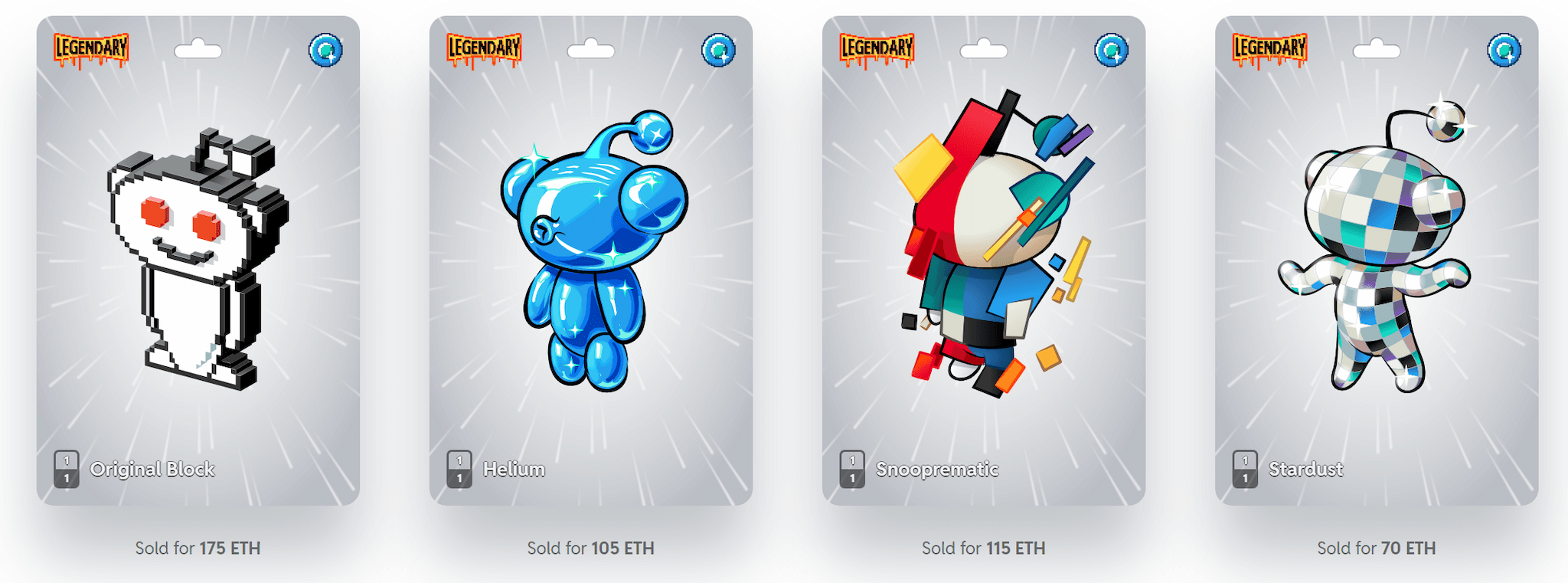
On July 7, 2022, Reddit announced a new NFT initiative that will let users set NFT-based avatars as their Reddit profile pictures. The NFTs will be tradable on a marketplace, accessible with a crypto wallet. Reddit partnered with Polygon to release a limited edition NFT collection called CryptoSnoos. Based on its mascot Snoo, the NFTs will be minted on the Polygon blockchain, making them compatible with the Ethereum blockchain.
Polygon Partnerships in Automobile
Polygon x Bentley Motors
Polygon has formed a partnership with Bentley Motors, a British luxury car manufacturer, as the company enters the Web3 ecosystem. This entails the launch of Bentley’s Genesis NFT collection, which consists of 208 NFTs on the Polygon blockchain. Bentley has promised to direct the proceeds from the NFT’s direct sales to support students interested in design, engineering, and manufacturing. Bentley chose Polygon’s carbon-neutral blockchain to push its sustainability initiatives, which include achieving carbon neutrality by 2030.
Polygon x Mercedes
Daimler South East Asia, a subsidiary of the Mercedes Benz Group, has developed a blockchain-based data-sharing platform called Acentrik, an end-to-end data exchange platform built for enterprises. Acentrik enables the tokenization of data into NFTs, which enterprises can trade on the Polygon network. The initiative hopes to create an equitable environment where small enterprises have access to sufficient data to train their machine learning and artificial intelligence models.
Polygon Partnerships in Food and Beverages
Polygon x Starbucks
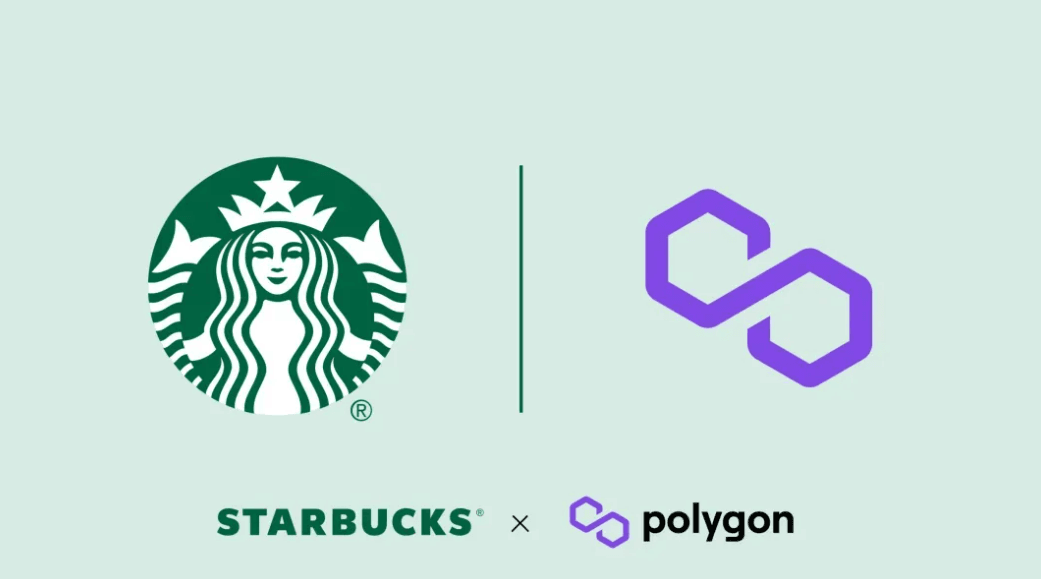
Polygon entered a partnership with the leading global coffee chain, Starbucks Coffee Company, to power its Web3 initiative, Starbucks Odessey. With this partnership, the company will engage with its Starbucks Rewards loyalty program members with NFT offerings minted on the Polygon PoS network.
Polygon x Coca-Cola
The global beverages giant Coca-Cola has partnered with Polygon to launch its new NFT collection on the Polygon network on International Friendship Day.
“International Friendship Day—which launched our metaverse journey in 2021—is the perfect milestone opportunity to thank and celebrate the people who have joined us,” said Pratik Thakar, Head of Global Creative Strategy, Coca-Cola. “We hope to strengthen and expand our ‘Real Magic’ community by building connections through a variety of physical and virtual Coca-Cola experiences.” – Coca-Cola
Polygon Partnerships in Fashion and Beauty
Polygon x Nike, Adidas, and Prada
Nike has been one of the most active adopters of Web3 technologies in the fashion industry. In 2022, Nike launched.Swoosh, a platform centered around Nike’s digital initiatives. The platform will spotlight the brand’s NFT collections and showcase virtual apparel. It will also farm customer engagement by allowing them to become co-creators and earn a share in product royalties.
Italian luxury fashion house Prada and sportswear giant Adidas announced a Web3-focused tie-up on X earlier this year.
Polygon x DIGITALAX
An NFT-based digital fashion project DIGITALAX also teamed up with Polygon to launch the first “real hybrid digital and physical fashion line”. DIGITALAX is pioneering a new concept called fractional garment ownership using NFTs.
Polygon Partnerships in E-commerce
Polygon x Flipkart
Polygon has partnered with Flipkart, one of India’s leading commerce businesses, to establish the Blockchain eCommerce Centre of Excellence. The center of excellence will explore ways to integrate blockchain technology into commerce and improve the shopping experience of millions of users.
Polygon x Venly & Shopify
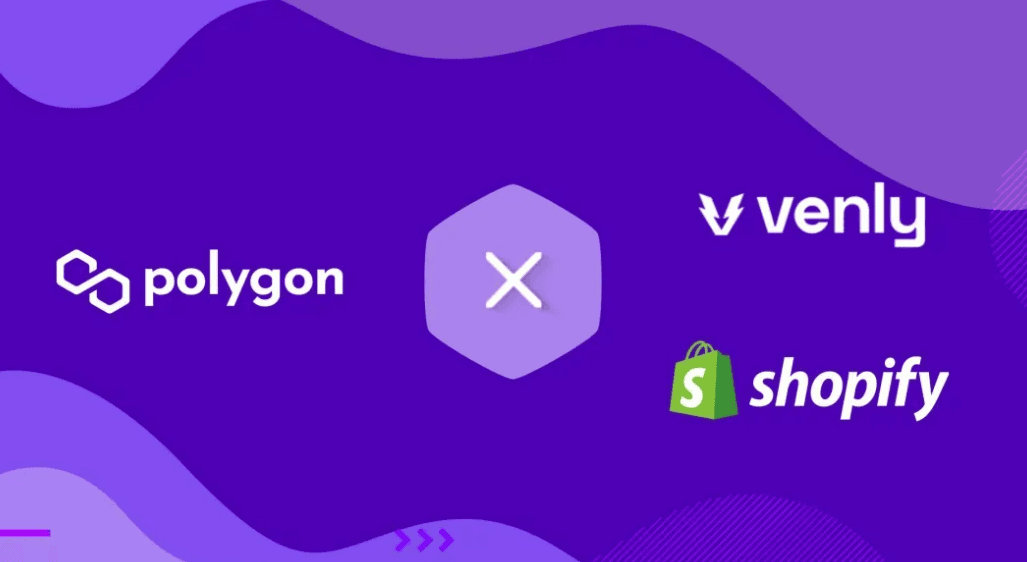
Venly is a blockchain technology company that integrated with Shopify, a global commerce solutions company, to create a new application for merchants to mint and sell NFTs. The app will operate on the Polygon POS network to leverage its low-friction environment.
Polygon Partnerships in Sports
Polygon x DraftKings
Polygon and DraftKings entered a strategic partnership to promote the adoption of Web3 technology in the gaming industry. The partnership will have the teams leverage their industrial expertise to develop the DraftKings NFT Marketplace, built on Polygon. DraftKings has also joined the Polygon ecosystem as a validator and node, further strengthening the relationship between the two companies.
Polygon x SPORTFIVE

SPORTFIVE is a sports and entertainment agency partnered with Polygon to push its blockchain initiatives.
Key aspects of the Polygon x SPORFIVE partnership –
- Enabling end-to-end growth strategies for sports rights-holders and brands across a range of Web3 initiatives, such as Metaverse, NFTs, DeFi, and DAOs.
- Efforts to educate, design, build, operate, and market all-encompassing and engaging Web3 experiences for brands and premium rights-holders in the sports and entertainment ecosystem.
- SPORTFIVE’s presence in the Web3 space provides Polygon with strategic connections to major sports brands and IP, enabling boundless opportunities for unique and powerful collaborations.
Polygon Partnerships in Technology
Polygon x Nothing
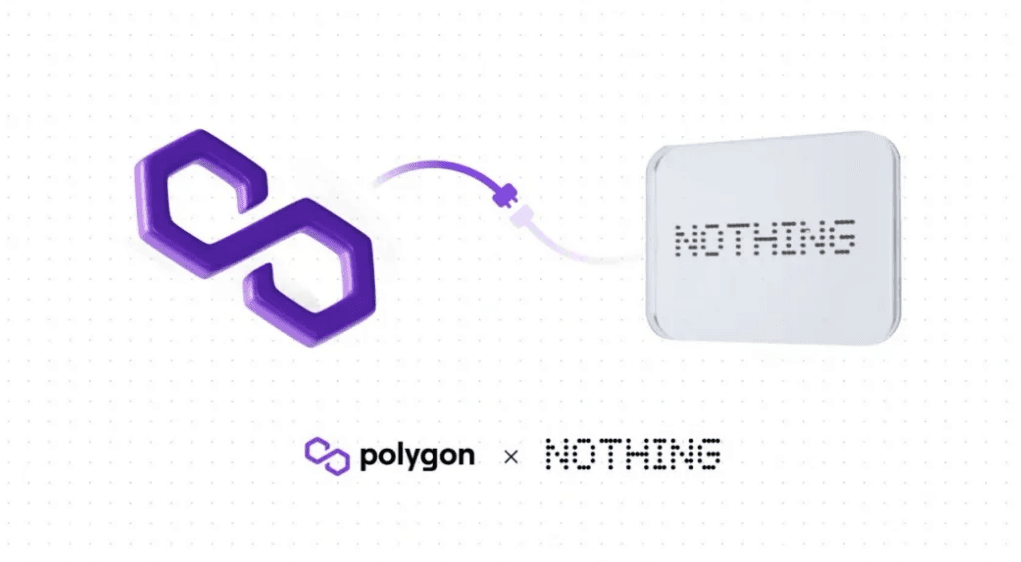
Nothing is an emerging technology company founded by OnePlus co-founder Carl Pei. The tech startup is partnering with Polygon to launch Nothing’s NFT loyalty program. The program comes with exclusive content, perks, merchandise discounts, and tickets to offline events. Nothing’s decision to use the Polygon ecosystem for its Web3 initiatives also stems from Polygon’s carbon-neutral network and its sustainability policies.
Polygon x Stripe
In April 2022, the global payment processing giant Stripe announced a partnership with Polygon to enable payouts to its creator community in cryptocurrency using Polygon. Polygon’s fast processing and low-cost blockchain network make it an ideal payment processing platform for Stripe.
Polygon Partnerships in Entertainment
Polygon x Disney
In July 2022, Polygon was one of the six companies selected to participate in Disney’s Accelerator Program. This partnership signifies a potential collaboration between Disney and Polygon to explore innovative technologies such as augmented reality (AR), non-fungible tokens (NFTs), and artificial intelligence (AI).
Key aspects of the Polygon x Disney partnership –
- Polygon being the only blockchain-native platform chosen for the program.
- The program aims to spur the growth of innovative companies worldwide.
- Each participating company will receive guidance from Disney’s senior leadership team and a dedicated executive mentor.
As part of the program, Polygon is working with Disney on developing a proof of concept for exclusive digital collectables to recognize Disney employees during special events.
Impact of Partnerships on Polygon’s Growth
Polygon has established itself as the industry standard channel for non-Web3 native companies looking to integrate the blockchain economy and its benefits to their business environment.
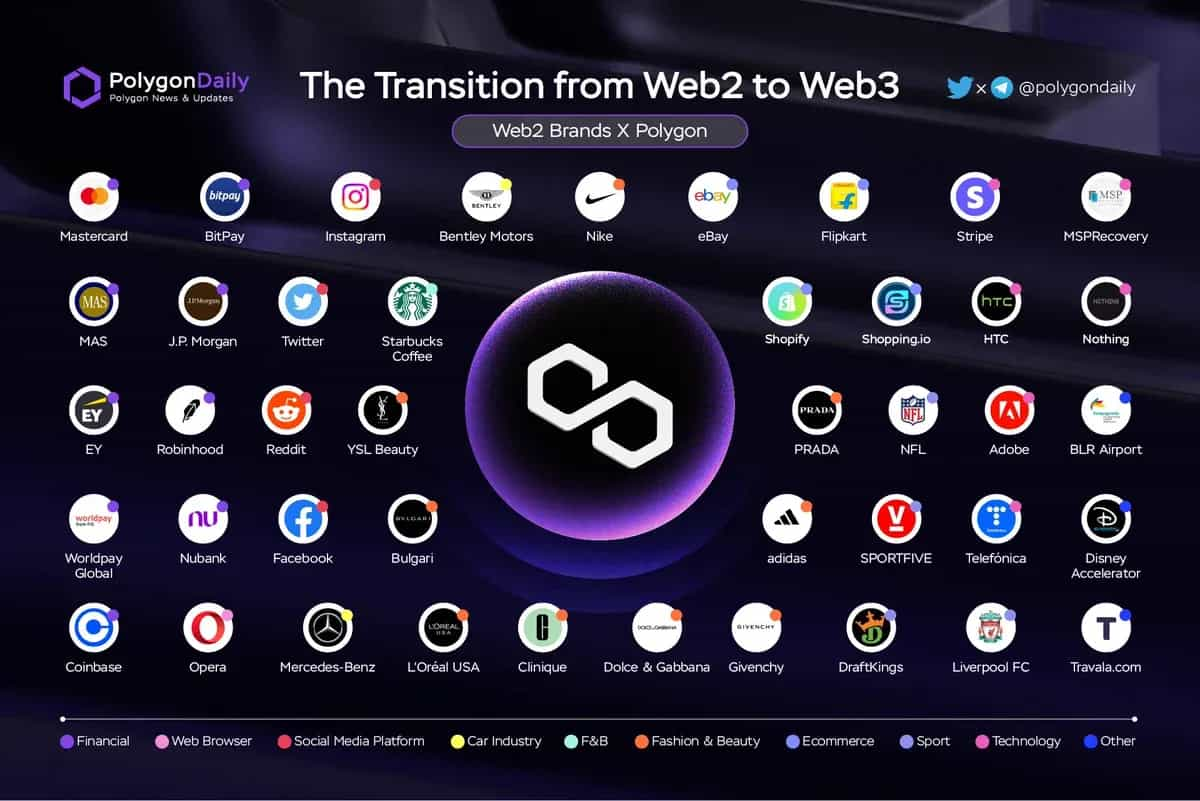
Let’s analyze how these strategic partnerships have impacted the growth of the polygon ecosystem in terms of –
Mainstream Adoption of the Polygon Ecosystem
Collaborating with brands in sectors untapped by Web3 exposes blockchain technology to a broader audience. Brands like Disney, Coca-Cola, Prada, and Bentley have nurtured respect and trust over several decades. Tying up with such brands not only introduces Polygon’s blockchain capabilities to a broader demographic but also lets it tether to their age-old brand loyalty.
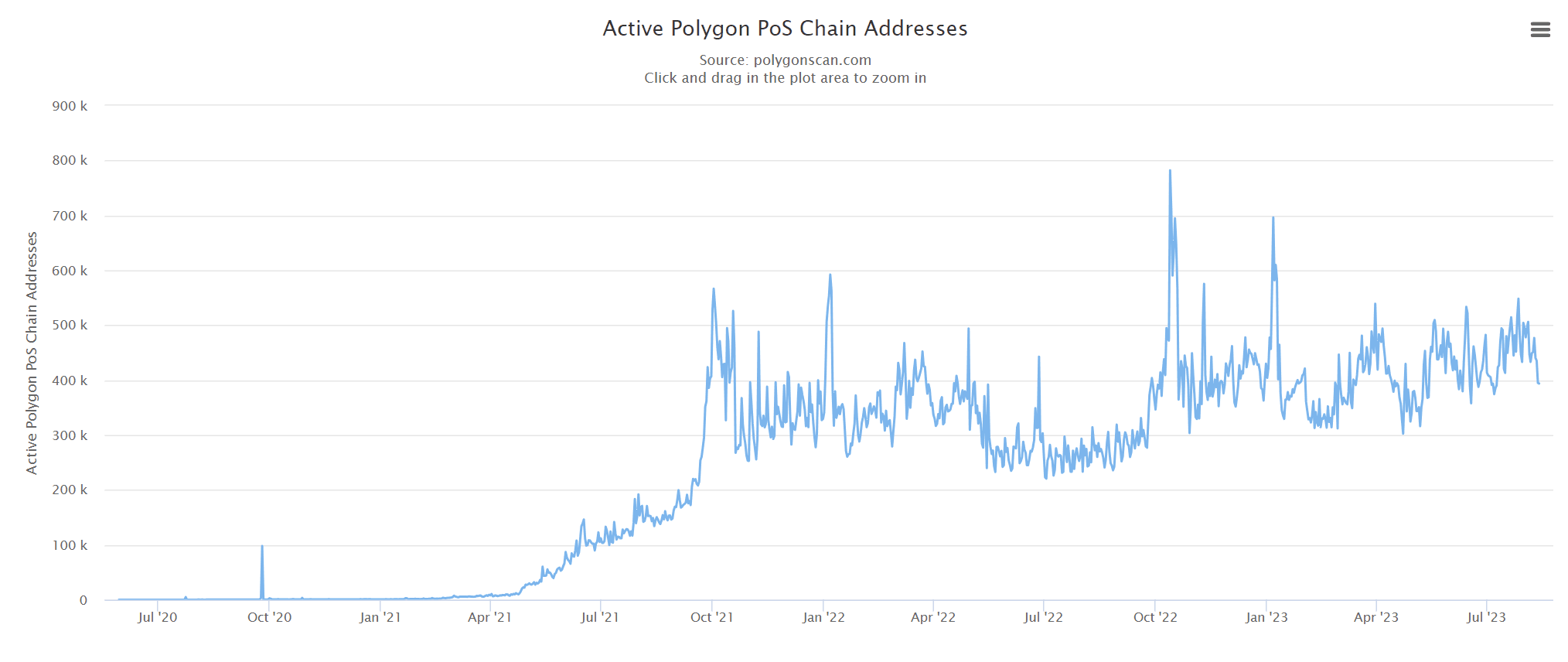
Enhancing the Utility of the Polygon Blockchain
Many of Polygon’s partner companies possess vast volumes of data and resources that could benefit from blockchain networks’ decentralization and tokenization capabilities. Polygon has been successful in tapping into these valuable reserves to create new utility and opportunities in the Web3 space. These partnerships have had multi-faceted impacts – They have revolutionized traditional sectors and pioneered new utility for blockchain technology, increasing network activity and potential for future innovations.
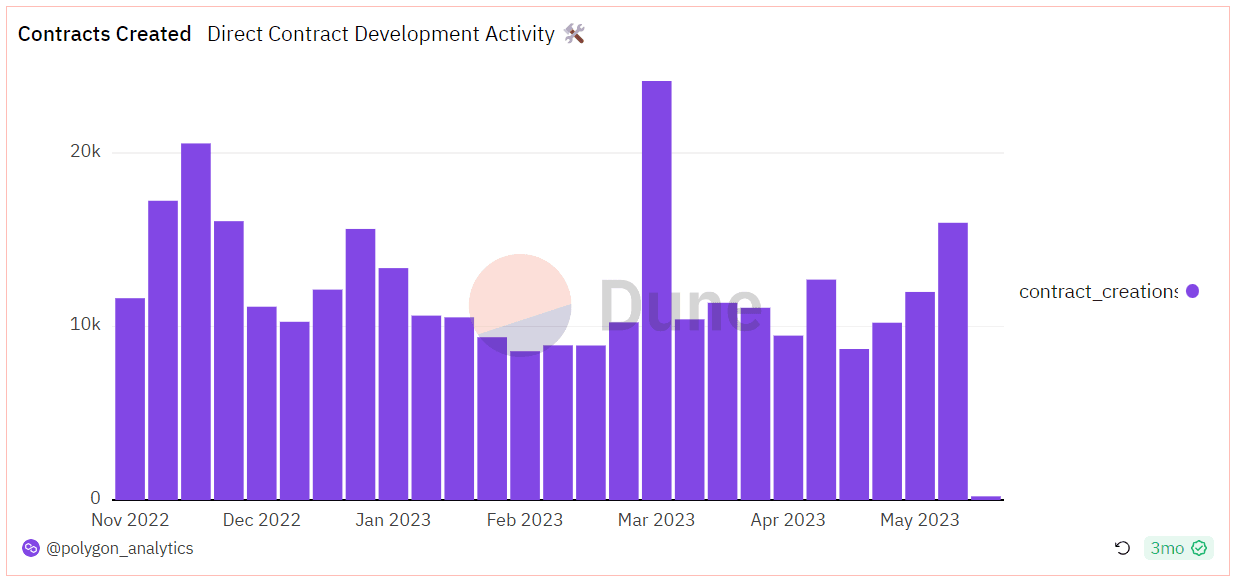
Market Differentiation From Other Layer – 2 Ecosystems
The Ethereum network layer-2 ecosystem is brimming with networks promising a decentralized, secure, high throughput and a low gas environment (Arbitrum, Optimism, and zkSync). Polygon’s strategic partnerships have helped it differentiate from the competition by becoming the critical incubator for non-Web3 native blockchain adoption.
Financial Growth and Stability of the Polygon Protocol
In February 2022, Polygon raised $450 million in a funding round led by Sequoia Capital India to support the development of Polygon PoS and scalability efforts. The resultant surge in the price of MATIC at the time raised the market cap of MATIC to $20 billion.
Strategic partnerships that create token and NFT sales and new use cases for the Polygon network also onboard significant capital into the ecosystem. These efforts lead to financial stability, especially in times of economic stress.
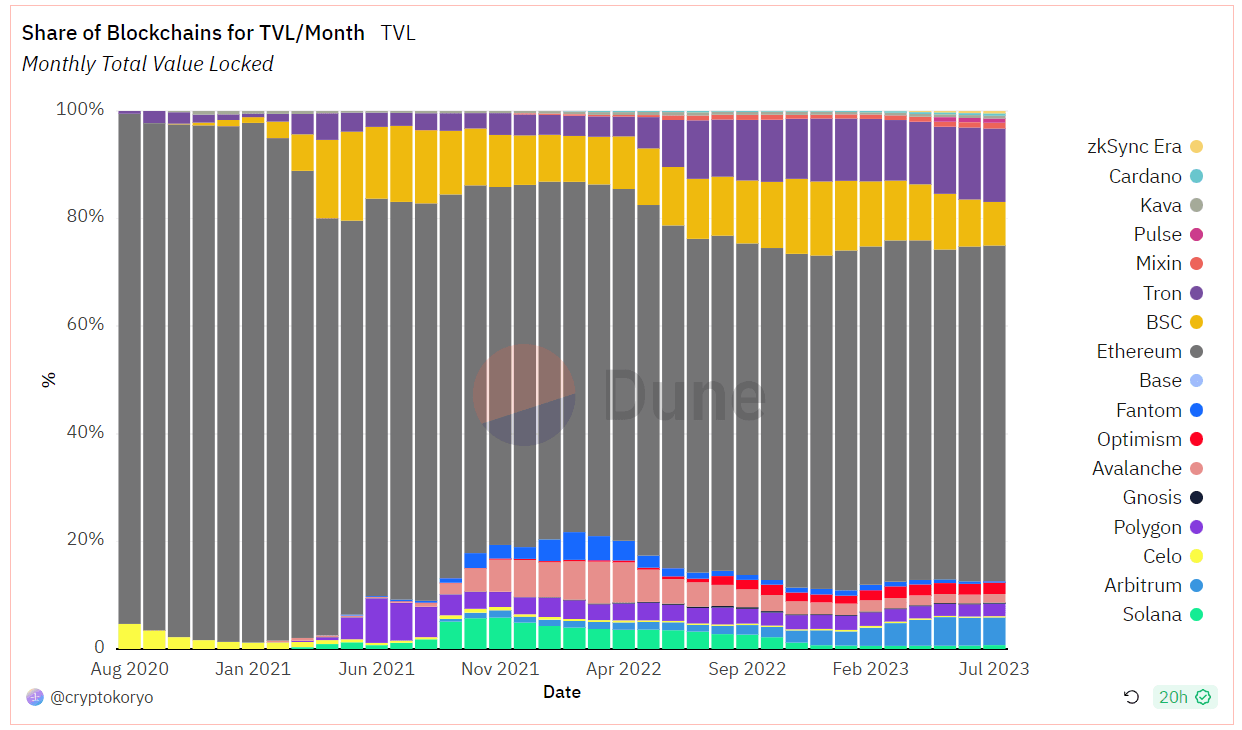
Promoting Education and Awareness of Web3 and the Polygon Ecosystem
Association with well-known brands effectively promotes the brand image of Polygon and blockchain education in general. This motivates other companies and industries to experiment with Web3.
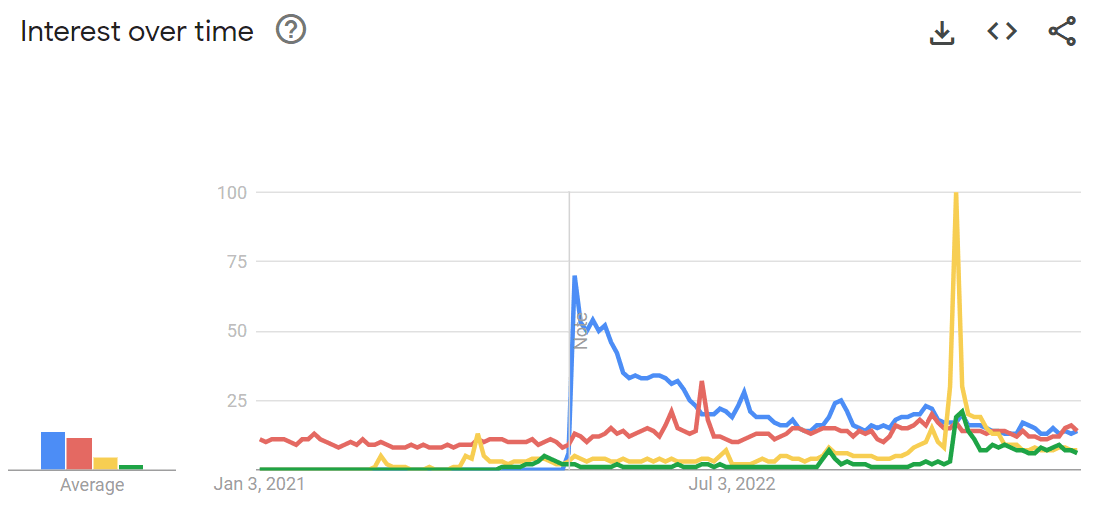
Performance of MATIC
While the MATIC token is not immune to the market swings induced by unfavourable regulatory and federal policies, the partnerships made by Polygon have certainly promoted MATIC’s value as a cryptocurrency. In November 2022, MATIC jumped 30% days after creating ties with Meta, JPMorgan, and Reddit.
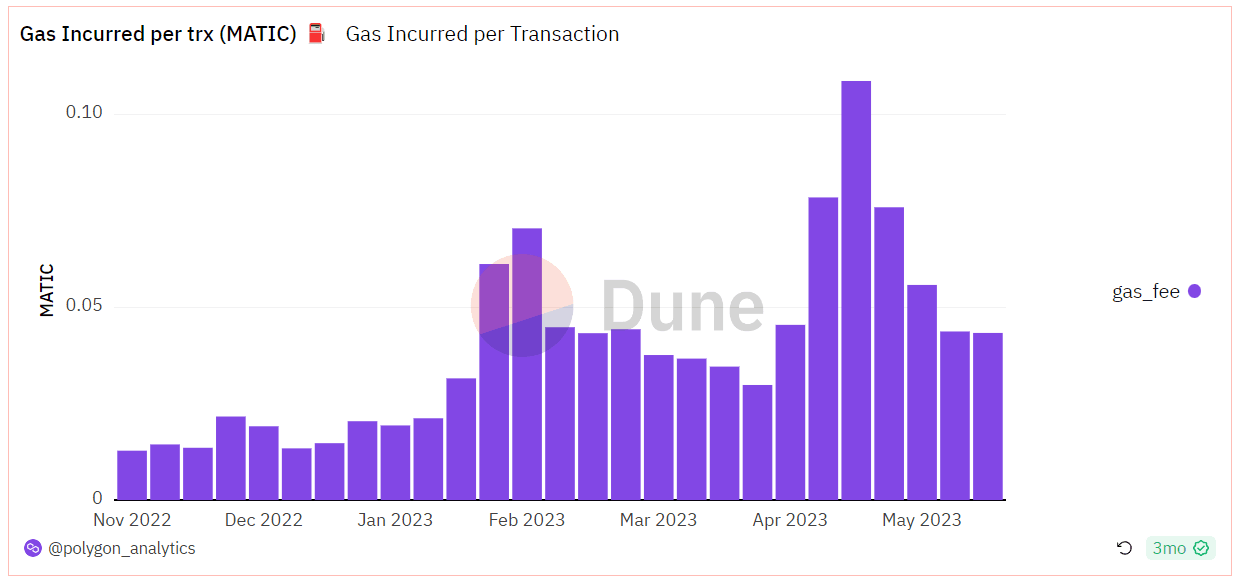
Polygon’s Partnerships: Competitive Analysis
Polygon adopts the most unique business strategies among the layer-2 ecosystems in its competition. Where other L2s focus on promoting Defi products and Web3-specific utilities, Polygon is aggressive towards onboarding Web2 products and businesses into Web3. Both strategies have their pros and cons. Polygon’s strategic decisions and positioning posed some challenges while providing certain advantages.
Polygon Partnership Strategy Challenges
Promoting a Web3-specific product to a blockchain-native audience is significantly simpler than onboarding traditional markets into Web3. Still, these markets have accumulated value over several years, making them excellent targets for disruption.
Polygon faces the following potential challenges while attempting this feat –
- Skepticism: Traditional businesses and brands that have cultivated a reputation over decades may be reluctant to associate themselves with controversial markets like cryptocurrencies.
- Competition: The open-source nature of blockchain technologies has made the industry highly competitive. Other layer-2 ecosystems offer similar technological benefits, making it hard to differentiate.
- Regulatory stress: The Web3 regulatory landscape is still evolving. Governments around the globe do not have an equivocal stance on crypto. Many blockchain services are constrained due to such regulatory blockades, which stand against Web3’s fundamental principles.
- Integration challenges: Integrating blockchain into existing systems can be complex or un-economic, which may deter brands from partnering in Web3
Polygon Partnership Strategy Advantages
Polygon has been notably successful in establishing partnerships and expanding its ecosystem. Its strategies offer certain advantages over the path undertaken by other ecosystems –
- Vision – Polygon’s vision expanded rapidly from a plasma chain for The Ethereum blockchain to offering multi-chain solutions to turn the Ethereum blockchain network into the internet of blockchains. Where other ecosystems specialized, Polygon’s all-encompassing approach helped it position itself as a Web3 global entity, which makes associating with other global brands feel intuitive.
- First-mover Advantage – The Matic Network was one of the first Ethereum blockchain scalability solutions, a clear head-start in building great products and establishing a reputation for themselves.
- User-Centric Products – Polygon forged partnerships that aimed towards providing solutions to users and creators. This enabled them to target many sectors and reach millions of users, incentivizing more consumer brands to associate with Web3 via Polygon.
- Marketing and Outreach – Polygon has been proactive in its marketing and outreach efforts. Not all projects place the same emphasis on this, and as a result, they may not be as visible to potential partners.
- Network effect – Every successful partnership Polygon forged in a new industry motivated more businesses from that sector to partner with Polygon.
- Resources – Polygon is one of the most handsomely funded layer-2 projects in the Ethereum ecosystem, providing it great liberty to experiment and organize massive marketing campaigns.
Anticipating Polygon’s Future: Forecasting the Path Ahead
Polygon’s multi-faceted approach to creating solutions for the Ethereum ecosystem lays a vast playing field for the project to explore in the future. Several niches within and outside Web3 have been stirring up in the past few years. Here are some ideas Polygon could tap into to stay relevant in the future –
Appchains on Polygon
Appchains are blockchain networks that are built for a particular use case. Polygon is already exploring this sector with Polygon Supernets. Supernets provide the sovereignty of L1 networks without their associated security-related overheads. As more use cases develop, Supernet partnerships have immense potential.
Polygon Powered Decentralized Identity Solutions
The Worldcoin protocol has reignited the debate over sovereign and digital identities. Polygon is among the frontrunners among the protocols that can effectively support an undertaking of this scale.
Metaverse and Virtual Worlds on Polygon
While Metaverse and NFT-related activity has dwindled in the past few months, the interest in this sector is still growing. The NFT market is expanding from collectibles to offering real utility like governance and real-world exclusivity. Polygon is already among the largest NFT ecosystem, increasing its chances of monetizing these trends.
Polygon Provided Enterprise Blockchain Solutions
The utility of blockchain as a private network within enterprises is still not well explored. Polygon can collaborate with enterprises to develop customized blockchain solutions.
These trends could prove lucrative avenues for the polygon ecosystem to penetrate with time. However, some big-picture clouds loom over the project’s potential for expansion; here are a few of them –
Polygon’s Competition
No other scalability project has tapped into the Web2 space as aggressively as Polygon, providing a clear playing field for the project to grow. However, this does not mean that Polygon’s competition would not change its future strategies to shift towards Web2. Polygon faces stark competition from the likes of Optimism and Arbitrum, who are quickly taking up market share.
Technological Advancements
New innovations and more efficient solutions are made all the time in crypto. Polygon is at the risk of one such innovation potentially making the Polygon’s system obsolete. However, the Polygon team has done a stellar job at adapting to such changes (like ZKP and Supernets) on time.
Regulatory and Monetary Policy
Blockchain is an evolving concept. Governments and businesses have only recently begun embracing the possibility of it having the potential to disrupt traditional policies and business models. The regulatory outlook of Web3 still remains indecisive.
Speculative industries like Web3 have suffered one of the worst blows of global monetary policies to fight rampant inflation.
Closing Thoughts: Jack of All Trades, Master of Some
Polygon can offer diverse services and solutions while excelling and pioneering in crucial areas that matter most to its users and developers. Its all-encompassing approach portrays a compelling image for brands to associate with. The project has made diverse collaborations across Defi and several traditional sectors while showing excellent competency in innovating new technologies and exploring uncharted territories. If the Polygon team keeps up with its reputation, it will continue to spearhead further collaboration in Web3.
- SEO Powered Content & PR Distribution. Get Amplified Today.
- PlatoData.Network Vertical Generative Ai. Empower Yourself. Access Here.
- PlatoAiStream. Web3 Intelligence. Knowledge Amplified. Access Here.
- PlatoESG. Automotive / EVs, Carbon, CleanTech, Energy, Environment, Solar, Waste Management. Access Here.
- PlatoHealth. Biotech and Clinical Trials Intelligence. Access Here.
- ChartPrime. Elevate your Trading Game with ChartPrime. Access Here.
- BlockOffsets. Modernizing Environmental Offset Ownership. Access Here.
- Source: https://www.coinbureau.com/analysis/polygon-partnerships/





